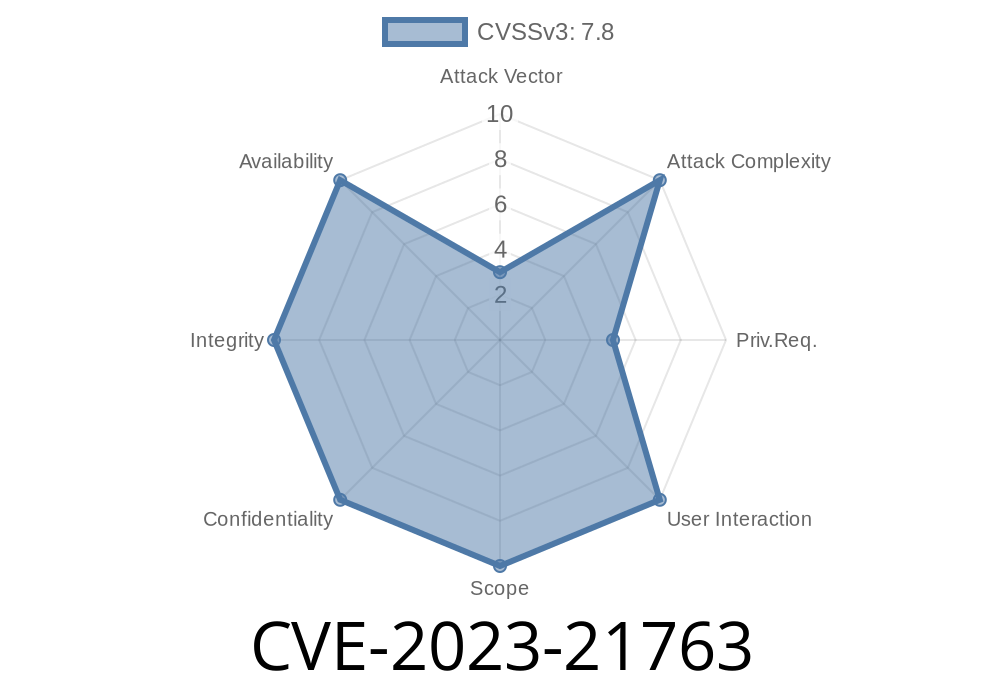In 2023, Microsoft disclosed several vulnerabilities in its Exchange Server product line. Among these, CVE-2023-21763 stands out as a critical Elevation of Privilege (EoP) flaw, which, if left unpatched, could enable attackers to gain unauthorized access or higher permissions on the system.
This post takes an in-depth yet easy-to-understand look at CVE-2023-21763. We'll explain what it is, how attackers might abuse it, show code snippets for illustration, provide links to trusted references, and offer practical advice to keep your systems safe.
> Note: This vulnerability is distinct from CVE-2023-21764, which is a separate issue.
What is CVE-2023-21763?
CVE-2023-21763 is an Elevation of Privilege vulnerability impacting Microsoft Exchange Server. Exploiting this flaw lets an attacker gain higher-level access, potentially allowing them to act as another user or system administrator.
Technical Details
The vulnerability arises due to a failure in handling permissions correctly within certain Exchange Server components. This allows a local, authenticated attacker to run commands with SYSTEM or privileged user rights.
For instance, an attacker with minimal access could use crafted PowerShell commands, exploit insecure file permissions, or manipulate Exchange Server's service processes to escalate their privileges.
Exploit Example
Warning: The following code is for educational purposes, to help system administrators understand how attackers might exploit this vulnerability. Never use it for unauthorized access.
Let's walk through an exploit logic using PowerShell, inspired by analyses in the security community
# Potential Privilege Escalation via Service Abuse in Exchange Server
# 1. List Exchange Server services running with SYSTEM rights
Get-WmiObject win32_service | Where-Object {$_.DisplayName -like "*Exchange*" -and $_.StartName -eq "LocalSystem"}
# 2. Check for writable paths in service binaries
$services = Get-WmiObject win32_service | Where-Object {
$_.DisplayName -like "*Exchange*" -and $_.StartName -eq "LocalSystem"
}
foreach ($service in $services) {
$path = $service.PathName -replace '"',''
if (Test-Path $path) {
$acl = Get-Acl $path
if ($acl.Access | Where-Object { $_.FileSystemRights -match "Write" -and $_.IdentityReference -match $env:USERNAME }) {
Write-Host "Writable Exchange service binary detected: $($service.Name) at $path"
}
}
}
# 3. (Dangerous) Attacker could replace the binary with malicious payload and restart service for SYSTEM shell
What this means:
The example above checks for Exchange Server services where the binary/executable file might be writable by a non-privileged user. If such a service exists, an attacker could replace the binary and restart the service, causing malicious code to run as SYSTEM.
Microsoft Security Response Center:
- Official CVE-2023-21763 Advisory
- Microsoft Exchange Server - Download Center
- Microsoft Exchange Team Blog
You can check all current Exchange Server security updates and guidance here:
Exchange Server Security Updates – Microsoft Docs
1. Install Official Patches
Microsoft released security updates that address this vulnerability.
> Install the latest Cumulative and Security Updates for your deployed Exchange Server versions.
Audit Exchange Server file permissions.
- Ensure only trusted administrators have write access to Exchange executable directories (like C:\Program Files\Microsoft\Exchange Server\V15\).
- Use tools like AccessChk from Sysinternals to review permissions:
# Example usage with Sysinternals AccessChk
.\accesschk.exe -qwuc "C:\Program Files\Microsoft\Exchange Server\V15"
4. Limit Direct Access
Where possible, restrict who can log on locally or via RDP to the Exchange Server.
Conclusion
CVE-2023-21763 is a serious privilege escalation bug in Microsoft Exchange Server that further illustrates why patching and proper permission management are so critical. Attackers with even limited access can potentially become SYSTEM users by exploiting simple misconfigurations when this CVE is unpatched.
Monitor activity: Watch out for privilege escalation attempts.
By following these steps, you’ll keep your organization a lot safer from this and similar attacks.
Further Reading
- NIST NVD CVE-2023-21763 Entry
- Exchange Server Security Best Practices (Microsoft)
Timeline
Published on: 01/10/2023 22:15:00 UTC
Last modified on: 01/18/2023 18:32:00 UTC
